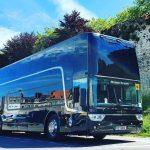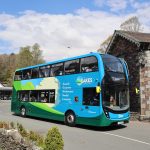Wrightbus will utilise Cummins power in its StreetDeck Ultroliner diesel double-decker for the first time in a next-generation variant of that model.
Those vehicles will be powered by the six-cylinder B6.7 engine rated at 250bhp or 300bhp, driving through the Voith DIWA.8 seven-speed automatic gearbox. Such an approach will further reduce emissions, and the new model will be Ultra-Low Emission Bus accredited by Zemo Partnership, the manufacturer says.
The existing StreetDeck Ultroliner, which is powered by the Daimler OM 934 four-cylinder engine, will continue to be available. The first Cummins-powered examples are to be supplied to Isle of Man operator Bus Vannin.
Notably, Wrightbus says that using the latest Cummins engine platform opens the latest-generation StreetDeck Ultroliner to potential repower with a hydrogen combustion engine from the same manufacturer mid-life. Cummins previously showed an example of its hydrogen-powered B6.7H unit.
Wrightbus CEO Jean-Marc Gales acknowledges that “not everyone has the funding to be able to make the switch to zero-emission.”
He thus says that the vehicle manufacturer thus believes “in a blended approach of responsible technologies; battery-electric, hydrogen fuel cell, and the cleanest diesel to ensure all our customers can continue to decarbonise as quickly as possible, while still maintaining financially viable operations.”
Adds Mr Gales: “The combination of the latest generation of engines from Cummins and the latest technology from Voith, coupled to our industry-leading Micro Hybrid technology, means that the StreetDeck UIltroliner offers optimal efficiency in the diesel market. We are delighted that Bus Vannin will be the first customer to experience our new offering.”
Bus Vannin Director Ian Bates notes that the five StreetDeck Ultroliner buses ordered from Wrightbus are the first double-deckers procured by that operator since the pandemic period.
They will deliver what he describes as “a progressive step forward in a known technology, the internal combustion engine, while continuing to take into account the Isle of Man Government’s Island Plan and commitments to climate change.”
Adds Mr Bates: “Technologies continue to advance at an astonishing rate, but this controlled approach allows us to see how the network will look in the future, enabling an insight into possible hydrogen options alongside electrification.”



























